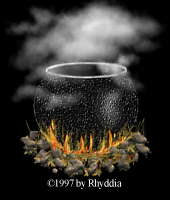

Virtually every religion can look back into the dark corners of history and find a period when it was held in disrepute. Some religions were accused of crimes through ignorance and malice, while others faced prejudice and inquisitions. Unfortunately, witchcraft, or the religion of wicca, has had perhaps the longest history of misjudgments, accusations, and persecutions. The witchcraft hysteria and consequent reign of terror gripped Europe and New England well into the 19th century. Even in present times, the words 'witch,' 'witchcraft,' and 'wicca,' ward off and repel people who have no real knowledge of the religion. Perhaps through knowledge and an open mind, one can bring the religion of witchcraft out of the broom closet.
Unlike some film portrayals, witches do not fly on brooms or vacuum cleaners, worship the devil, or conspire to harm others. Nor do they always dress in black capes and pointed hats, cast spells over a boiling cauldron, or keep the company of black cats and full moons. Films such as The City of the Dead (1960), Hocus Pocus (1993), Little Witches (1996), and Macbeth (1997), portray the stereotypical coven of flying and black magic-practicing witches. In addition, children's films like The Wizard of Oz (1939) and A Simple Wish (1997) have capitalized on the 'evil witch' versus the 'good fairy' typecast. Throughout the years, these stereotypes and other untruths have been built from people's lack of true knowledge about the witchcraft religion.
Witchcraft is an earth religion based on pre-Christian European traditions. Often called one of the oldest religions existent in the West, its origins can be traced back to the Paleolithic people who worshiped a Fertility Goddess and a Hunter God. Witchcraft takes its teachings and inspirations from nature by re-linking with the life-forces of nature. The sun, moon, and stars are looked to for their insights and information, as well as trees, birds, animals, and seasonal cycles. Many diverse traditions or sects exist within the religion because covens (groups of witches) and individuals derive their practices from various cultural and ethical sources. For the most part, modern witches hold rituals according to personal needs, the turning of the seasons, and the tides of the moon. However, many of the modern traditions and even 'old traditions' are different from the ancient Pagan practices because of the religion's ambiguous history.
The witchcraft hysteria can be traced back to a 15th century inquisition that laid the groundwork for a reign of terror that gripped Europe and New England well into the 19th century. During this period it is estimated that more than nine million men, women, and children were accused of being witches, and either tortured or burned. In the late-1400s, the Christian Church instituted the task of Witch-hunters to combat what was believed to be the sorcery and black magic of witches. A century later, an archbishop in Germany accused 120 villagers of causing severe weather, and all 120 were burned to death as witches for interfering with the elements. Yet, perhaps the most infamous witchcraft craze was the Salem witch trials in 1692 that were related to a group of young girls. The consequent onset of hysteria in New England can be seen in such films as Dr. Terror's Gallery of Horrors (1966), Matthew Hopkins: Witchfinder General (1968), Teen Witch (1989), and Hocus Pocus (1993) which make some kind of reference to the Salem witch trials. The long history of witchcraft misjudgments, accusations, and persecutions forced the surviving craft to go underground until the 19th century.
Nonetheless, it wasn't until the 1950s that
the last laws against witchcraft were repealed in England and
modern witchcraft was brought to the attention of the public.
Since then, modern witchcraft has considerably grown as more
people are drawn to reconnect with the old ways and the earth.
Many feminists have turned to witchcraft for healing and strength,
while others are attracted to the greater understanding of oneself
and the universe. Witches believe there is much to learn by studying
their past-through myth, ritual drama, poetry and music, love
and living in harmony with the earth. By coming out of the broom
closet, witches hope to educate the world about the unique religion
of witchcraft.